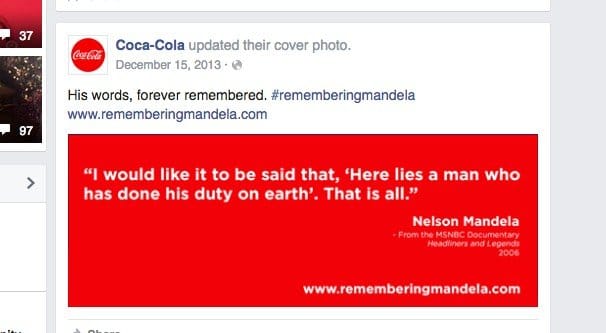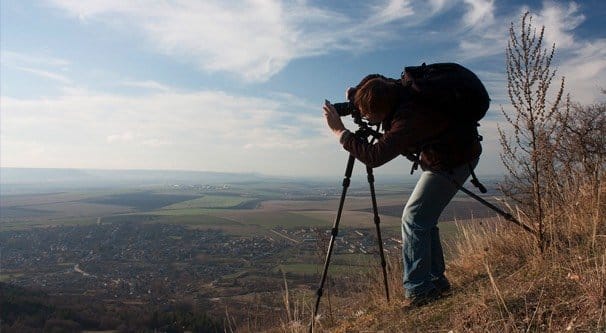 Written by ContentPowered.com
Written by ContentPowered.com
We all know that imagery does far better than pure text on Facebook. The way edgerank works, images are given higher priority, so they show up more often and have a wider reach. The thing is, this has led to a world where every post has an image attached, or is a shared photo itself. We’re not gaining any advantage from using images; we’re just establishing a new baseline.
So what can we do to boost our photo likes? Here are some of my favorite tips.
1. Post High Quality Photos
The number one best way to get more likes and engagement on your Facebook photos is to post better photos. It’s the same as any other form of content; the better the content, the more people will be interested in it. Of course, it can be very demoralizing to look at big pages that post garbage and get 100x the engagement you do. The thing is, they’ve been at it way longer and have way more resources than you do. Don’t worry about them. If you must compare yourself to someone else, find someone with a similar sized audience and similar industry.
If you have to, go ahead and do some reading on basic photo composition and editing. All too often, I see people claim they’re posting high quality images when they’re really just the most basic and boring pics you could set out to create. There are elements to image composition that have held true since the renaissance, there’s a reason they exist and are codified.
By contrast, you can always go to the bottom of the barrel to get engagement. After all, you’re not necessarily after the engagement itself. What you’re after is an increase in edgerank with your followers. It’s simple; the more a person interacts with your page, the more they’ll see your posts. The less they engage, the fewer posts they see. Therefore, if you get them to engage with the bottom of the barrel clickbait, they’ll be there to see your more relevant sales posts.
The idea here is to create an image that’s split between two choices. Sports teams in upcoming games work well, as do simple and basic choices, like cake or pie. Then ask your users to vote. A share counts for one team, a like counts for the other. That’s it! You can sit back and watch the engagement roll in. It’s not necessarily great engagement, but it works.
3. Bait Likes For Support
By supporting a common popular cause, you can draw in a lot of sympathy support. People like to show solidarity. You can do this with some of Facebook’s event tools, for one thing. Remember the gay marriage profile picture tool that overlaid your picture with a rainbow flag? That’s what I’m talking about. The public show of support and the change work together to draw in users who also support that cause.
On a more tragic note, the badge with a blue line whenever a police officer is killed is another such option. I don’t recommend attempting to capitalize on tragedy very often, but occasionally it can work, particularly if you have a personal story about the officer or if they were present in your home town.
4. Put Text on Images
Facebook has a rule against too much text on images, but it only applies to ads. If you’re running organic posts, you can put as much text as you want. This is why some of the low quality viral image sharing engines do nothing but post degraded screenshots of text posts on Tumblr or the like.
I don’t recommend that you go that route. Instead, come up with motivational quotes, inspirational sayings, and other sorts of interesting text to put on top of images. You can, if you want, come up with some kind of specialized theme. Science facts on top of nebulas, movie facts on top of screenshots, that sort of thing.
Text often enhances the viability of images because, while you have a description, most people don’t really read it. They’ll read what’s on the image, but they’ll ignore the description itself.
5. Run Caption Contests
A weekly caption contest can go a long way towards bringing your imagery to the fore. You need an audience that sees enough of your posts to spread it, which is probably the hardest part. You also need some sort of basic prize; something you can afford to give out weekly. I recommend a simple bit of store credit or a discount coupon. From there, all you need are strange images that beg explanation. The wilder the image, the better. If it looks like something Gary Larson might have drawn, go for it.
The idea with a caption contest is to get people commenting, so you should actively monitor the comments. Prune out and weed out the comments that aren’t relevant; anything violent, racist, or otherwise against the Facebook terms should be removed. You can also remove unrelated posts; I’ve seen people spam every post a brand makes with a copy-pasted support request that should go through a ticket system instead. Drop those.
6. Ask Questions to Solicit Comments
Much like the idea of “share one, like the other” above, you can solicit a more open-ended set of comments by asking questions. You can do this in two ways; you can ask questions that are relevant to your business, or you can ask questions that are simply there to get to know your audience. For example, you could ask what type of flowers your audience likes. Does it help your business? Probably not, not unless you’re a florist. What it does is get people commenting and potentially debating the merits of various flowers.
On the other hand, you can ask brand-relevant questions. For example, if you have a product with a few flaws, you can ask users what the most glaring flaws are and what they might do to fix them. You’re essentially just crowd-sourcing market research here. The vocal minority might not have good ideas, but they can give you an idea of what sort of issues people face when they use your product.
On a similar note, you can ask for what people might want out of your brand next. If you have a line of shoes, you can ask what color they want next. Anything you can think to ask, there will be people willing to answer.
7. Post Socially Relevant Images
This one is a double-edged sword, so only use it sparingly and only when you really, really know your audience well. Social issues tend to be very divisive. I would never post a “like if you’re a democrat, share if you’re a republican” image, for example. Politics tends to be too high-stakes for a brand page. People will comment on your posts, sure; but they’ll do it because they’re fighting.
Various social issues, like abortion, gun control, gay marriage, drug legalization, and so forth can have very strong opinions associated with them. You want to limit your images about these kinds of topics to a rarity. For example, the NRA can get away with posting about gun control frequently, but that’s because they know their audience and, more importantly, know what side of the issue they’re on.
The main thing to remember is that every social issue with such a divisive set of options will cause you to lose followers if you take one side or the other. Some people will leave just because you posted about it; they don’t want to see it at all, regardless of your stance. On the other hand, they do tend to get people talking, so it’s a high risk, high reward scenario.
8. Post During Peak Hours
One of the elements of edgerank – that is, one of the factors that goes in to determining if a person sees your post – I the recency of that post. How long ago was it posted? How long ago was the most recent bit of engagement on the post? Older posts need more and more ongoing engagement in order to stay alive, unless they’re old enough that fresh engagement might be important. In general, though, the idea is that newer posts are given more weight.
This can be seen in action on a daily basis. All you need to do is post at midnight for a week to see how little engagement you get compared to posting during peak hours.
Now, there are a lot of studies out there about the ideal times to post on each social network. I recommend taking a look at them, but you also need to take them with a grain of salt. If you’re in a strange industry or if your audience has something unique that sets them apart, their peak hours might be different. Study your audience and figure out when works best for them.
9. Post Unique Content
There are approximately infinity pages out there that do nothing but share the same memes and internet jokes they find on third-string sites. They pull from other Facebook pages, which pulled from 9gag, which pulled from another Facebook page, which pulled from Imgur, which pulled from Reddit. These pages post jokes and humor months out of date.
You’re not going to be one of these brands. You won’t be able to grow with that kind of business model. It’s simply too saturated and too low-value to work any more. Instead, you need to focus on creating unique content. Be the one to bring value to Facebook. If you must, curate Reddit’s front page or Imgur’s most viral, but do it in a way that keeps you ahead of the curve.
There are two reasons you should avoid using hashtags on Facebook. The first is simply that they drop your engagement levels by a surprising amount. Part of the problem is the way they were implemented initially; they only showed content using the tags amongst your friends, rather than globally, like every other social network out there. This helped give Facebook tags a bad name. It’s highly recommended that you don’t use them.
The other reason to avoid them is because they’re so much more common on Twitter and Instagram. If you’re posting an image with a short description and a handful of hashtags on Facebook, people are going to think it’s just auto-posted from one of those two sites. When you auto-post across networks, people tend to engage less, because they assume you’re not paying attention. It’s a good assumption; automation tends to hurt engagement unless you’re on top of managing it.
11. Avoid Excessive Editing
The more you edit a photo, and the less experience you have with editing, the worse the final product will look. The best edits are basic touch-ups, light filters, and color correction. Don’t go all-in with the HDR filters, the sepia, the color vibrancy, or strange effects. For the love of God, don’t try to make something that looks like it was run out by Blingee. Likewise, avoid manipulating elements of one image into another unless you’re sure you’re good at what you’re doing. Get someone else to verify.
12. Change With The Season
Changing up your profile images and cover photos is a good way to spur engagement based on the season. Even if it’s as simple as adjusting your profile picture to match the holiday, with rabbit ears for Easter, Christmas lights for Xmas, or a pumpkin for Halloween, it works. You can even browse some of those huge lists of holidays and find one each week to change to. People will tune in just to see what strange holidays you pick and how you choose to portray them with your logo.
Above all, you should strive to post plenty of image content. If you’re trying to get more likes on photos, you’re going to be emphasizing the graphical elements of your brand, which means you need to be a content producer. Every picture is an opportunity for more engagement. So long as you’re not posting a dozen times a day, you’re probably good.





